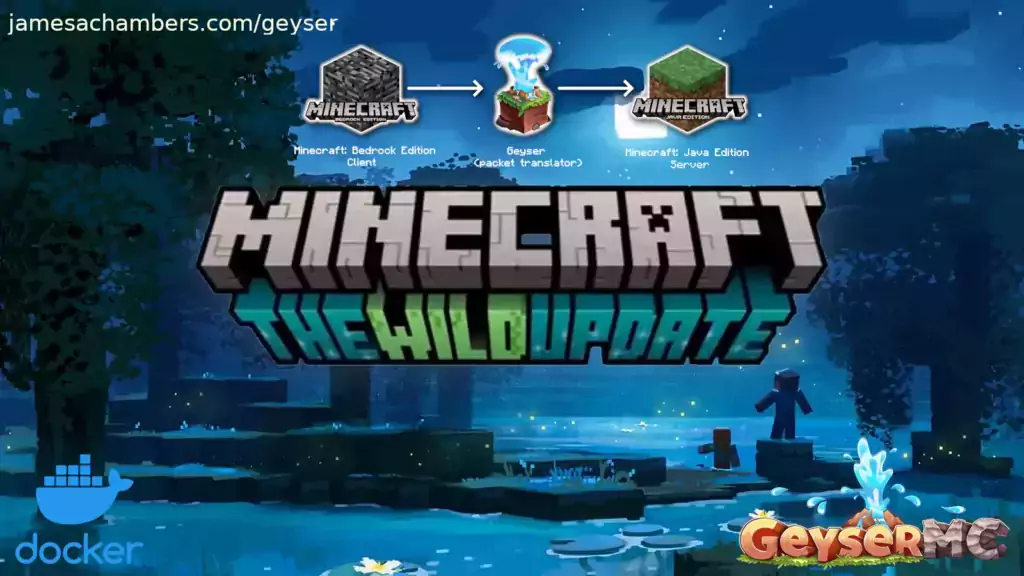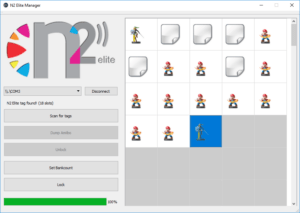
This is a new Docker container to automatically set up and run a Minecraft server that both Java and Bedrock players can connect to! This allows everyone to play on your server no matter which edition of Minecraft you are using. It uses the Geyser and Floodgate plugins to accomplish this.
Since it uses the Paper Minecraft server it also supports any additional plugins that are compatible with Paper / Spigot. This gives you the ability to do many things that are currently impossible to do in Bedrock if you are hosting the official Bedrock dedicated server.
It is fully compatible with my Paper Minecraft Java Server Container and you can swap between these two containers without changing any configuration.
The official GitHub page is located here.
The Docker Hub page for the container is located here.
It’s now possible to convert your worlds between Bedrock and Java versions. Check out my guide on Chunker here for more information.
Features
- Sets up fully operational Minecraft server that allows both Java and Bedrock clients to connect
- Runs the highly efficient “Paper” Minecraft server
- Runs Geyser to allow Bedrock clients to connect and Floodgate to allow them to authenticate with their Bedrock credentials to a Java server
- Plugin support for Paper / Spigot / Bukkit
- Uses named Docker volume for safe and easy to access storage of server data files (which enables more advanced Docker features such as automatic volume backups)
- Installs and configures OpenJDK 18
- Automatic backups to minecraft/backups when server restarts
- Full logging available in minecraft/logs folder
- Updates automatically to the latest version when server is started
- Runs on all Docker platforms including Raspberry Pi
Usage
First you must create a named Docker volume. This can be done with:
docker volume create yourvolumename
Now you may launch the server and open the ports necessary with one of the following Docker launch commands.
With default ports:
docker run -it -v yourvolumename:/minecraft -p 25565:25565 -p 19132:19132/udp -p 19132:19132 --restart unless-stopped 05jchambers/legendary-minecraft-geyser-floodgate:latest
With custom ports:
docker run -it -v yourvolumename:/minecraft -p 12345:12345 -e Port=12345 -p 54321:54321/udp -p 54321:54321 -e BedrockPort=54321 --restart unless-stopped 05jchambers/legendary-minecraft-geyser-floodgate:latest
With a custom Minecraft version (add -e Version=1.X.X, must be present on Paper’s API servers to work):
docker run -it -v yourvolumename:/minecraft -p 25565:25565 -p 19132:19132/udp -p 19132:19132 -e Version=1.17.1 --restart unless-stopped 05jchambers/legendary-minecraft-geyser-floodgate:latest
With a maximum memory limit in megabytes (optional, prevents crashes on platforms with limited memory, -e MaxMemory=2048):
docker run -it -v yourvolumename:/minecraft -p 25565:25565 -p 19132:19132/udp -p 19132:19132 -e MaxMemory=2048 --restart unless-stopped 05jchambers/legendary-minecraft-geyser-floodgate:latest
Using a custom timezone:
docker run -it -v yourvolumename:/minecraft -p 25565:25565 -p 19132:19132/udp -p 19132:19132 -e TZ="America/Denver" --restart unless-stopped 05jchambers/legendary-minecraft-geyser-floodgate:latestSkipping backups on a certain folder:
docker run -it -v yourvolumename:/minecraft -p 25565:25565 -p 19132:19132/udp -p 19132:19132 -e NoBackup="plugins" --restart unless-stopped 05jchambers/legendary-minecraft-geyser-floodgate:latestSkipping permissions check:
docker run -it -v yourvolumename:/minecraft -p 25565:25565 -p 19132:19132/udp -p 19132:19132 -e NoPermCheck="Y" --restart unless-stopped 05jchambers/legendary-minecraft-geyser-floodgate:latestChange number of backups:
docker run -it -v yourvolumename:/minecraft -p 25565:25565 -p 19132:19132/udp -p 19132:19132 -e BackupCount=1 --restart unless-stopped 05jchambers/legendary-minecraft-geyser-floodgate:latestConfiguration / Accessing Server Files
The server data is stored where Docker stores your volumes. This is typically a folder on the host OS that is shared and mounted with the container. I’ll give the usual locations here but if you’re having trouble just do some Googling for your exact platform and you should find where Docker is storing the volume files.
You can find your exact path by typing:
docker volume inspect yourvolumenameThis will give you the fully qualified path to your volume like this:
{
"CreatedAt": "2022-05-09T21:08:34-06:00",
"Driver": "local",
"Labels": {},
"Mountpoint": "/var/lib/docker/volumes/yourvolumename/_data",
"Name": "yourvolumename",
"Options": {},
"Scope": "local"
}
On Linux it’s typically available at:
/var/lib/docker/volumes/yourvolumename/_data
On Windows it’s at
C:\ProgramData\DockerDesktop
but may be located at something more like
\wsl$\docker-desktop-data\version-pack-data\community\docker\volumes\
if you are using WSL (Windows Subsystem for Linux).
On Mac it’s typically
~/Library/Containers/com.docker.docker/Data/vms/0/
If you are using Docker Desktop on Mac then you need to access the Docker VM with the following command first:
screen ~/Library/Containers/com.docker.docker/Data/com.docker.driver.amd64-linux/ttyYou can then normally access the Docker volumes using the path you found in the first step with docker volume inspect.
Most people will want to edit server.properties. You can make the changes to the file and then restart the container to make them effective.
Backups are stored in the “backups” folder
Log files with timestamps are stored in the “logs” folder.
Plugin Support for Paper / Spigot / Bukkit
This is a “Paper” Minecraft server which has plugin compatibility with Paper / Spigot / Bukkit.
Installation is simple. There is a “plugins” folder on your Docker named volume.
Navigate to your server files on your host operating system (see accessing server files section if you don’t know where this is) and you will see the “plugins” folder.
You just need to drop the extracted version of the plugin (a .jar file) into this folder and restart the container. That’s it!
Some plugins have dependencies so make sure you read the installation guide first for the plugin you are looking at.
A popular place to get plugins is: dev.bukkit.org
Troubleshooting Note – Oracle Virtual Machines
A very common problem people have with the Oracle Virtual Machine tutorials out there that typically show you how to use a free VM is that the VM is much more difficult to configure than just about any other product / offering out there.
It is because there are several steps you need to take to open the ports on the Oracle VM. You need to both:
- Set the ingress ports (TCP/UDP) in the Virtual Cloud Network (VCN) security list
- *and* set the ingress ports in a Network Security Group assigned to your instance
Both of these settings are typically required before you will be able to connect to your VM instance. This is purely configuration related and has nothing to do with the script or the Minecraft server itself.
I do not recommend this platform due to the configuration difficulty but the people who have gone through the pain of configuring an Oracle VM have had good experiences with it after that point. Just keep in mind it’s going to be a rough ride through the configuration for most people.
Troubleshooting Note – Hyper-V
There is a weird bug in Hyper-V that breaks UDP connections on the Minecraft server. The easy workaround for this is that you have to use a Generation 1 VM with the Legacy LAN network driver.
There is a second fix that was shared by bpsimons here. For that fix you need to install ethtool first with sudo apt install ethtool. Next in your /etc/network/interfaces file add “offload-tx off” to the bottom as the issue appears to be with TX offloading.
Here’s an example:
# The primary network interface auto eth0 iface eth0 inet static address 192.168.1.5 netmask 255.255.255.0 network 192.168.1.0 broadcast 192.168.1.255 gateway 192.168.1.1 offload-tx off
This can also be done non-persistently with the following ethtool command:
ethtool -K eth0 tx offAdditional Support
The comments section right here is the best place for support. The second best place is the GitHub issues section.
I will add additional documentation based on what problems people are running into / questions people are asking because right now I’m not really sure what those will be yet. Definitely let me know if you need any of these things!






FYI to everyone running this; Geyser just updated, so if you run:
docker run -it -v yourvolumename:/minecraft -p 25565:25565 -p 19132:19132/udp -p 19132:19132 -e Version=1.21.6 –restart unless-stopped 05jchambers/legendary-minecraft-geyser-floodgate:latest
you’ll be able to have the latest bedrock and java client versions join your server again.
Thanks! My kiddo just got a new Switch 2 and I was afraid there was some type of mismatch. This should solve it.
Hi James and everyone,
Something weird recently happened to my server. It was deployed on Oracle Cloud and the hardware that I was on was retired, so they automatically transfered my instance to new hardware. Since the transfer, the server is still running fine, but when I navigate to the docker volume, it’s completely empty. Previously, there was a folder (or maybe mount point) at home/user/volumes with my docker volume inside. home/user/volumes is now empty. When I use “docker volume ls” I see the name of my volume, but I’m not sure why I can’t even navigate to it, let alone FTP in to update my plugins. Any help would be amazing
Try “docker volume inspect ” to see where it’s actually stored in the filesystem. If you don’t know the name of it, tab-completion (hit tab twice after typing “inspect”) should list the available volumes.
Inspect returns the following:
“CreatedAt”: “2023-12-11T13:19:41Z”,
“Driver”: “local”,
“Labels”: null,
“Mountpoint”: “/var/lib/docker/volumes/akycraft/_data”,
“Name”: “akycraft”,
“Options”: null,
“Scope”: “local”
So it *is* there 😂 I’m not sure why it’s suddenly not appearing where it was before though or how to get it back 😥
I did set up this server a couple of years ago and I can’t remember every step I took. Now I’m wondering if that volume that I’d been interacting with at /home/user/volumes appeared automatically during setup or if it was a mount point that I’d made manually 😂
I think you can tell that I don’t really know what I’m doing
I just set up a server using this docker image and so far it’s working great. I had a couple questions about things I’m trying to do and hoped you might have some insight as to whether it’s possible, and if so, how. For some context, I’m running the docker container on an Ubuntu 24.x box as a service started by systemd via a unit file in /etc/systemd/system.
The first thing I’m trying to figure out is whether I can run this as a service in the background and then later connect (attach?) to it as needed if I need to run any server console commands. Right now if I run docker manually using the -it flags, everything starts up and drops me at a console prompt and I can run console commands just fine. If I run it as a service, however, it won’t let me use the -t flag since systemd doesn’t provide a tty-like interface for stdout. If I run it detached (-dit), the minecraft service exits and then systemd immediately tries to restart it, resulting in the minecraft server never actually getting started because systemd is continually trying to restart it. If I run it as a service without -i or -t flags, I can attach to the container later, but it doesn’t seem to actually take my input or provide any output to stdout.
The second thing I’m trying to figure out is if it’s possible to pass arguments to the actual java command that starts the server. I know there’s at least one option for specifying the amount of memory you’d like it to be able to use, but I was thinking about things like “–bonusChest” or other arbitrary arguments that would be passed to the minecraft server jar at the time of execution.
Any thoughts, help, suggestions on either of these would be greatly appreciated.
Ethan, I use ctrl + p, ctrl+q to exit the console, then docker attach to re-open the console. Hope that helpls.
Am using latest version of minecraft on iOS, v1.21.62, getting below erros:
[Geyser-Spigot] Bedrock user with ip: /10.0.1.194 has disconnected for reason Outdated Geyser proxy! This server supports the following Bedrock versions: 1.21.40 – 1.21.44, 1.21.50 – 1.21.51
Seems this require a rebuild of the container? I am using the latest version sha256:65b7f35c0e7e65221d7610b695d8f3adc64f12f4f4de116dd8abc33b14239782
Hey Fai,
Geyser is not built into the container. It always downloads the latest version when you restart the server. I see support for 1.2.62 was added on 2/27 to Geyser here.
You should just need to restart the server to get the latest Geyser. Hopefully that helps!
Further to my previous comment, this seems pertinent.
[root@minecraft-server opc]# docker images
REPOSITORY TAG IMAGE ID CREATED SIZE
05jchambers/legendary-minecraft-geyser-floodgate latest b4e69b0aee3e 8 months ago 437MB
I learned how to pull a new image update.
docker image pull 05jchambers/legendary-minecraft-geyser-floodgate:latest
This worked! Docker run command now working correctly.
Hey Kody,
Thanks for sharing your solution, that should take care of this for anyone else having trouble pulling the latest version!